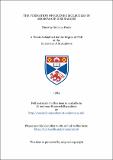Files in this item
The formation of excimer molecules in microwave discharges
Item metadata
| dc.contributor.advisor | Maitland, Arthur | |
| dc.contributor.author | Frank, Timothy Graham | |
| dc.coverage.spatial | 170, [50]p. | en_US |
| dc.date.accessioned | 2018-06-05T10:13:51Z | |
| dc.date.available | 2018-06-05T10:13:51Z | |
| dc.date.issued | 1984-07 | |
| dc.identifier.uri | https://hdl.handle.net/10023/13716 | |
| dc.description.abstract | Experimental and theoretical aspects of the formation of excimer molecules in gas discharges are described. Experimental studies are of the emission spectrum of rare-gas halide molecules, produced in a microwave discharge, and cover aspects relevant to rare-gas halide lasers and to the possibility of pumping these lasers by microwave discharge. The experimental work consists mainly of an extensive programme testing mixtures of a rare-gas (Xe, Kr, or Ar) with a halogon donor (SF6, NF3, or HCl) and a buffer gas (He, Ne, or Ar). The majority of work concerns KrF and XeF but some results are also presented for ArF, XeCl, and KrCl. The spectrum of XeO is observed. The main variables are mixture ratio and total pressure and the principal measurements are available either from integrated spectra or from temporal records of the intensity at the spectrum peak. The results form an empirical optimisation study. One of the aims of this study was to find the mixture ratios and total pressures for which the fluorescent emission, for any given excimer system, was a maximum. These ratios and pressures could then be used as a starting point in attempts to obtain lasing. Considerable use was made of SF6, as the donor because it is a cheap alternative to NF3 and has not been studied in detail as a donor elsewhere. Results are extracted from the main body of results in order to compare the performance of these two donors and to compare the performance of the three buffers. It is shown conclusively that greater lifetimes are obtainable with SF6 but at the cost of lower intensities. In the buffer comparision much lower fluorescent emission is observed when Ar is used, in both XeF and KrF mixtures, and that discharges are only formed below about 100Torr. Below the optimum dilutions the results for He and Ne aresimilar. However, at higher dilutions in XeF and KrF mixtures, fluorescent intensities are significantly greater, and discharges may be obtained at greater total pressure, with Ne buffer. In XeF mixtures it is found that gas lives are 4 to 8 times as long with Ne buffer as they are with He buffer. The temporal records provide gas life information on a scale ranging from 300 to 10<p>6 pulses. To reveal behaviourover fewer pulses and within single pulses a high speed system (5ns response time) was developed using a monochromator, fast photomultiplier, and storage oscilloscope. Because of the very small ratio of the pulse width to the inter-pulse period a blanking system was devised to remove the over-bright base line occurring during the inter-pulse period. The high repetition rate of 1100pps and much reduced volume enabled gas life studies to be carried out in times which are orders of magnitude smaller than those required using the 10pps of a conventional excimer laser system with much greater volume. (Abstract shortened by ProQuest.) | en_US |
| dc.language.iso | en | en_US |
| dc.publisher | University of St Andrews | |
| dc.subject.lcc | TK7871.3F8 | |
| dc.subject.lcsh | Lasers | |
| dc.title | The formation of excimer molecules in microwave discharges | en_US |
| dc.type | Thesis | en_US |
| dc.contributor.sponsor | SERC | en_US |
| dc.type.qualificationlevel | Doctoral | en_US |
| dc.type.qualificationname | PhD Doctor of Philosophy | en_US |
| dc.publisher.institution | The University of St Andrews | en_US |
This item appears in the following Collection(s)
Items in the St Andrews Research Repository are protected by copyright, with all rights reserved, unless otherwise indicated.

